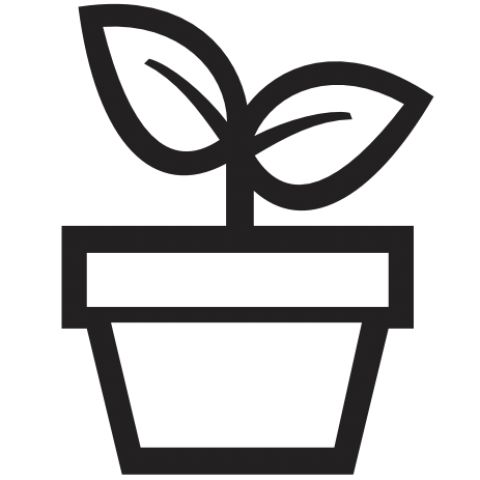I n 2022 we added a new houseplant icon. This symbol marks plants we think will grow well indoors year-round in window light. You’ll find houseplants throughout the catalog, many of them in the Outdoor/Indoor or Miniatures & Succulents sections.
n 2022 we added a new houseplant icon. This symbol marks plants we think will grow well indoors year-round in window light. You’ll find houseplants throughout the catalog, many of them in the Outdoor/Indoor or Miniatures & Succulents sections.
Houseplants provide the obvious visual interest of foliage and flowers, but can also improve the indoor air quality in our homes. Plants such as English ivy, aloe vera, and tropical spiderwort are among the best for scrubbing indoor air. Some houseplants are easy to grow, coping well with lower light levels and dry air indoors. Among the easiest we offer are snake plant, Chinese money plant, jade tree, Swiss cheese plant, begonias, and happy bean. Succulents in general are on the easy end of things as long as you don’t over-water them.
Other houseplants are well worth a bit of extra care. Maidenhair ferns and baby tears need either diligent watering or to grow in terrariums, which satisfy their need for high humidity. If you’re using a mixture of plants in a terrarium, be sure all have the same needs, only add water when soil is dry, and/or mist for moisture. Since space is limited, start with small plants.
Dish gardens are attractive for succulents. Again, choose plants that share the same needs—this time for dry conditions—as well as being proportionate in size and slow-growing. Houseplants can have quite long lifespans, becoming old friends and even being passed down as an inheritance, like grandma’s tropical spiderwort or English ivy.
While we want to reserve the new houseplant symbol for plants that will be happy without ever needing to spend time outside or in a garden, some gardeners pot up favorite nonhardy plants from their garden to extend the joys of summer. These plants over-winter indoors and then return outside to the garden for another growing season. Many will look great as temporary houseplants and some will even bloom, while others’ highest aspiration is to survive until they can return outdoors.
Container-grown plants are easy to transfer from garden to house and back to the garden again because their roots are already at home in a pot. Purple-leafed oxalis, miniature creeping figs, and fancy-leafed rex begonias are among the part-shade plants to treat this way. Indoors, these are happy in a bright but not sunny location. Plants that do need more sun, such as a hot pepper or a scented geranium, will appreciate as much light as you can give them. Herbs like creeping rosemary and chives can continue to provide snips for culinary use if given enough indoor sun (four hours).
Lantana, fuchsia, sweet potato vine, copperleaf, and many other sun-loving garden plants can be kept inside for the winter. An excellent source of information about over-wintering these tender perennials is Steve Silk’s article in Fine Gardeningmagazine.
When outdoor plants are brought into the house they should be thoroughly washed, including the pots, to eliminate bothersome insects. Doing a little research or getting some advice from a houseplant-loving friend to see what plants will work best in your house is a good idea. Let us know how your plants do as we gather information about which of our plants make great houseplants and which over-winter indoors successfully. —by Nancy, Carol, and Pat
One cautionary note: Lists of plants toxic to pets are found at ASPCA.org/apcc.